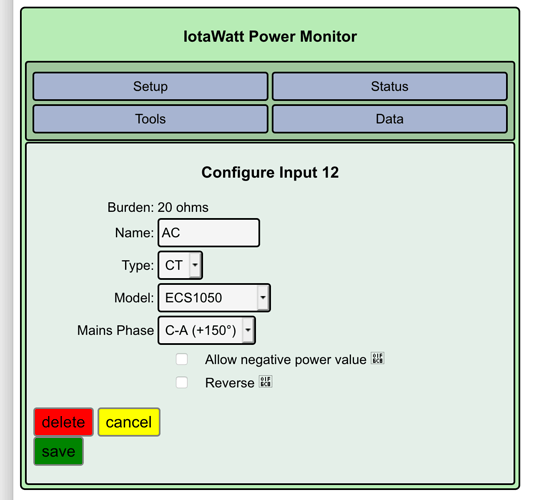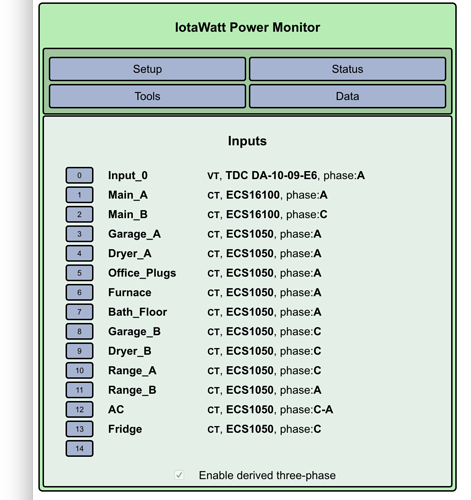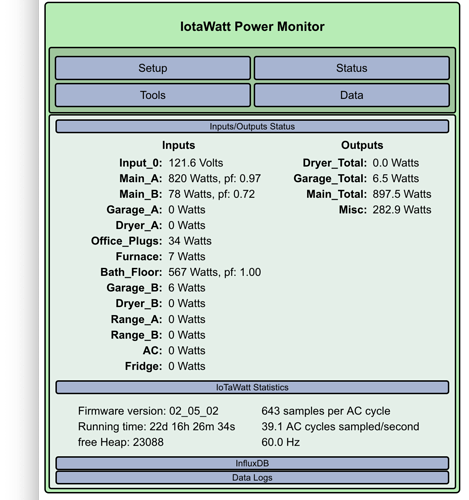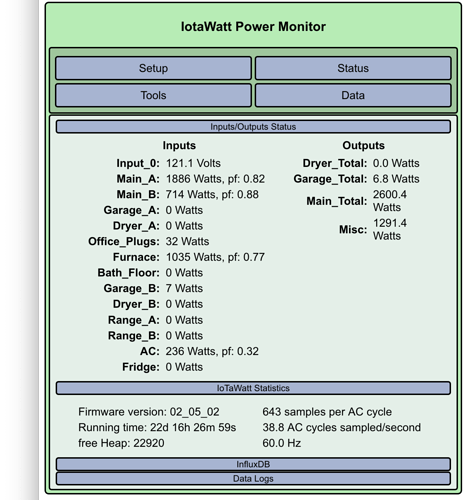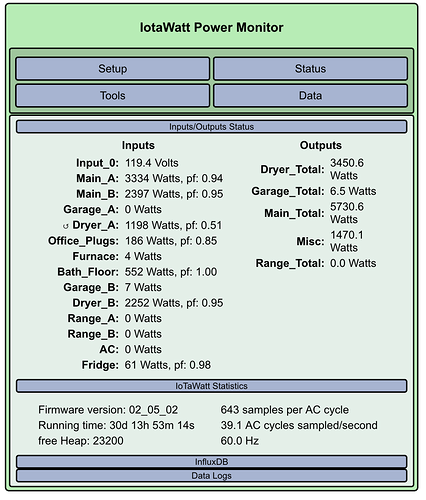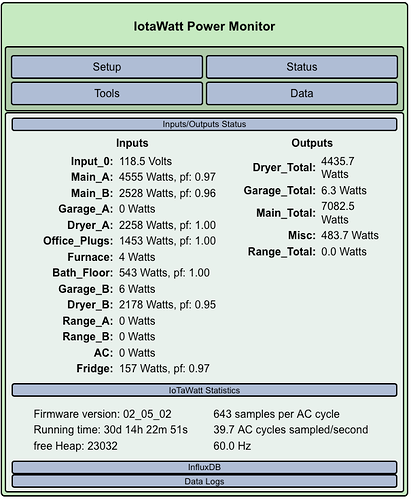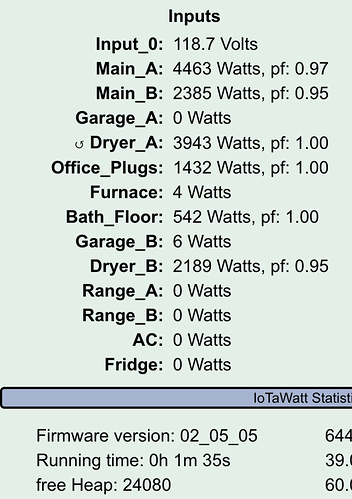You may remember me from such fantastic debugging posts as Is It split-phase or 120V/208V “two-phase”?, where I discovered that I have two legs of a three-phase power system in my home.
One of my circuits is a two-leg (eg. 208V/240V) air conditioning compressor. Based upon the previous discussion, I thought that this circuit could be monitored with one CT and the phase-to-phase configuration in the IotaWatt. Here’s how I thought it would go:
- Install CT (an 50A ECS1050) on one leg of the circuit, keeping an eye on which phase (A or C for me) that I install it on
- Connect to IotaWatt
- Configure IotaWatt input with “Mains Phase”, selecting the option that had the right phases being used in this circuit
- The IotaWatt input would then report the total power used on both legs
So, I installed the CT on the side of the breaker that was Phase C, and then configured the AC input:
Resulting in these inputs:
Then I checked the power readings before the AC was turned on…
And then cranked the A/C. In February. In Canada.
The AC circuit reported only 236W, pf 0.32, while overall power usage on the mains jumped much more than that. (Other circuits also changed; furnace → makes sense; bath_floor → unrelated bad luck to confuse this.)
Did I configure this phase-to-phase input correctly, or, misunderstand it?
Hi Mathieu,
I have to confess that I don’t have a site where I can extensively test this, so it may be a problem with IoTaWatt, but I have tested phase to phase in a remote environment with results that match the two CT measurements. So maybe it’s something else.
Your logic looks right, so first, can I ask if you have compared your mains kWh to your meter? Id like to be more confident that the basic phase assignments are correct.
I’m looking at your Furnace at 1035 Watts while the total is 2600 Watts. The power factor of the furnace is low compared to the Mains, and so that would require a very low power factor for the AC, which I doubt (never mind what the 0.32 in the display, that is clearly wrong).
Have you confidence now in the mains readings?
Checking against my utility power meter has been on my to-do list for a while… I’ll grab a couple readings and compare it over the next few days.
I thought the 1035W reading on the furnace was quite odd. It’s a gas furnace, and when running to heat the home it is drawing about 440W which I presume is for the blower fan. The AC runs with the same fan, so I expected to see around the same power draw on the furnace circuit, not > 2x on the furnace. Maybe there’s another component I’m not aware of on the furnace circuit though; I only have a rough mental model of the pieces here.
In addition to comparing the utility meter, I’ll turn on the AC a couple more times, let it run for a few minutes to ensure it is stable, and visually inspect all the mechanical. Maybe there’s a more benign explanation – I didn’t want to run it too long in the winter to take a close look.
All you need to do is read the meter periodically and note the date and time. I can show you how to get the equivalent record from IoTaWatt using Graph+.
I wouldn’t recommend running the AC at all. If you get liquid in the compressor, you could do damage. If you have a second, could you change the phase of the Dryer_A CT to C-A and grab a screenshot of the status display with it running please?
To get kWh between for any given period, run Graph+, under Watts units select Main_Total and then set the Start and End date/times. Click Data Statistics and the total kWh will be the last column.
OK, I’ve compared the IoTaWatt Main_A + Main_B to the utility power meter. I had a photo of my utility meter after we adjusted my IoTaWatt to use the derived 3-phase power, and just needed to collect the other data point and do the math. Long story short: the IoTaWatt is 1.19% higher power consumption over a 33 day period. I’d say that’s pretty on-point.
Here’s the status display, if I change Dryer_A to be C-A and run the dryer:
That’s good news that the mains are correct. On the other hand, the dryer A experiment is clearly wrong, and appears to be just plain wrong phase. I’ll revisit my calculations, but if you would try each of the other B-C and A-B references to see the Watts and power factor of each.
Thanks
With Dryer_A configured as A-B:
With Dryer_A configured as B-C:
A-B looks pretty interesting.
A-B is definitely the correct phase shift, so there’s something wrong with my tables. I’m also suspicious of the power being too low for a dryer. I’m wondering if the voltage is being factored correctly. Could you use the file-manager to edit the config.txt file and post it (if there are private keys, then pm it)
Hm, interesting. Here’s the config.txt; other than trimming out the influxdb key.
config.txt (3.2 KB)
Is that with Dryer_A set to Mains-phase A-B?
Oh, sorry, I had returned Dryer_A to phase A.
Here it is, when set to A-B:
{
"channel": 4,
"name": "Dryer_A",
"type": "CT",
"model": "ECS1050",
"phase": 1.6,
"turns": 1000,
"cal": "50.00",
"vmult": 1.732,
"vphase": 30
},
Looking back I see that there is a problem with the voltage factor in 02_05_02. That was fixed (actually just developed) in the following release. The current ALPHA and BETA release 02_05_05 has the correct code for voltage factor in phase to phase.
That release also has the wrong phase correction for the phase-to-phase shift. A-B is 30°. In the latest release it’s -30°, which will be wrong, however in the latest release C-A is -150° which is 180° from 30° which explains why the power is reversed.
Sorry if that’s not very clear. Bottom line, if you switch to ALPHA auto-update and go to 02_05_05, then edit Dryer_A to mains phase C-A, I think you will see power of about 3,910 Watts and PF 1.00. A 4,500 Watt 240V dryer should draw 3,900 Watts on 208V.
It should happen immediately.
Dryer_A on C-A, running on 02_05_05 is bang on your prediction:

1 Like
Great. Now I have to say that if your your dryer is three-wire, using two CTs as Dryer_A phase A and Dryer_B phase C and adding them is probably the more accurate way to measure as it will pick up the motor at 120V. You can look at what the sum of those two was before and see if there is a significant difference.
If it is three wire, you can use this phase C_A reference, run both conductors through the CT in opposite directions, and divide the result by two. There are just so many ways to deal with this.
Thanks for all your help with these experiments.
Sounds great. Thank you for the help!
